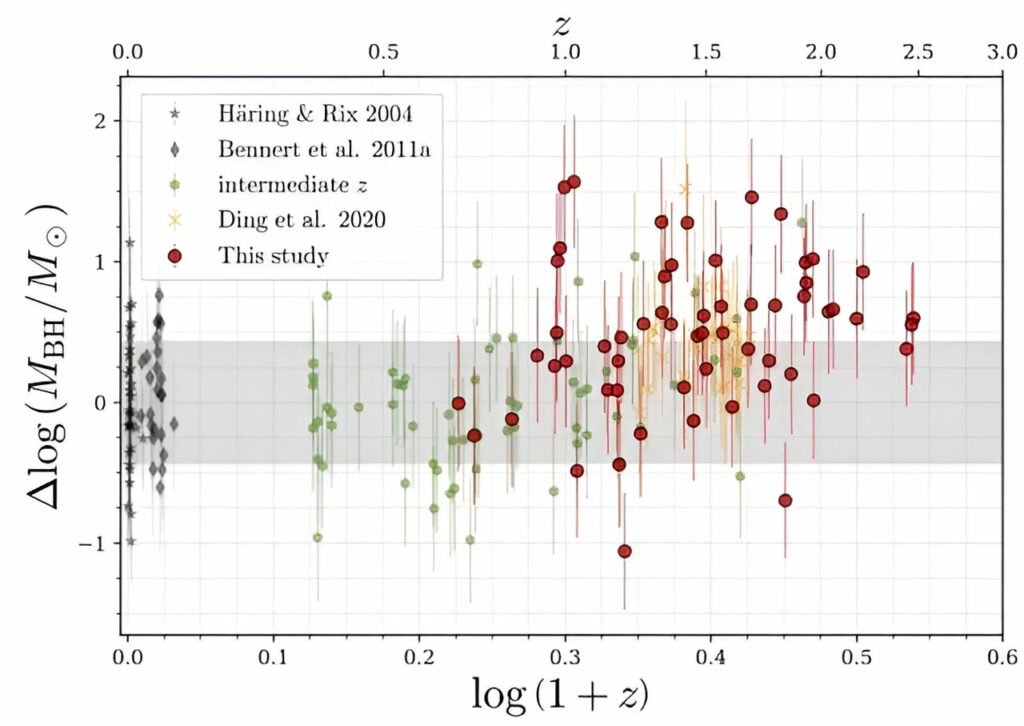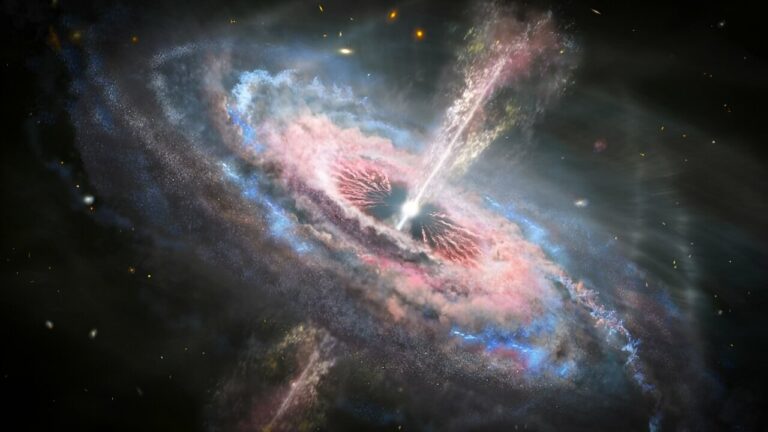Early Galaxies and Their Supermassive Black Holes: A Coordinated Growth Process
In nearly every galaxy, there exists a supermassive black hole, suggesting a significant connection between the two entities. It has been observed that the growth of galactic black holes can be influenced by the gas and dust within a galaxy, and the behavior of black holes can either stimulate or impede star formation, depending on their level of activity.
However, there is still limited knowledge among astronomers regarding the interaction between galaxies and their black holes in the early universe. Did black holes drive the formation of galaxies, or did early galaxies contribute to the growth of black holes? A recent study proposes that these two phenomena developed in tandem.
Studying the intricate dynamics of black holes and galaxies in the early cosmos is challenging. One approach to investigate this is by comparing the mass of a galactic black hole to the mass of all the stars in its respective galaxy. This can be represented as the ratio MBH / M*, which can be analyzed over time by measuring it at progressively higher redshifts. The redshift value indicates the age of the galaxy, with higher values corresponding to younger galaxies.
In this particular study, which was shared on the arXiv preprint server, the research team examined 61 galaxies with active galactic nuclei (AGNs) identified through X-ray observations. The luminosity of the AGNs provided an estimation of the black hole’s mass. Additionally, they incorporated data from the COSMOS-Web and PRIMER surveys conducted by the James Webb Space Telescope (JWST) to obtain the infrared luminosity of the galaxies, enabling them to determine the total stellar mass.
1. Almost every galaxy harbors a supermassive black hole, indicating a fundamental connection between the two entities. Furthermore, the growth of galactic black holes can be influenced by the presence of gas and dust within the galaxy, and the behavior of black holes can either stimulate or hinder star formation, depending on their level of activity.
However, there is still a lack of information among astronomers regarding the interaction between galaxies and their black holes in the early universe. Did black holes drive the formation of galaxies, or did early galaxies contribute to the growth of black holes? Recent research suggests that these two phenomena evolved simultaneously.
Observing the intricate dynamics of black holes and galaxies in the early cosmos is challenging. One method to study this is by comparing the mass of a galactic black hole to the mass of all the stars in its respective galaxy. This can be expressed as the ratio MBH / M*, which can be analyzed over time by measuring it at increasingly

The observed galaxies exhibit redshifts ranging from z = 0.7 to z = 2.5, indicating that these galaxies are being observed as they appeared 6 billion to 11 billion years ago. The researchers discovered a correlation between the growth of galaxies and their black holes. As the mass of the galaxy increases, so does the mass of the black hole. This relationship is approximately linear, although the ratio slightly favors the black hole at higher redshifts. For those with a mathematical inclination, the team determined that the ratio varies as MBH / M* = (1 + z)0.37. This implies that black holes grow at a slightly slower pace than galaxies.
Regrettably, there is a considerable level of uncertainty associated with this finding. To establish a more precise relationship, further observations, particularly at higher redshifts, will be necessary. However, astronomers should be able to collect this data in the upcoming years. This study demonstrates that galaxies and their black holes grow at similar rates over billions of years. Future studies will provide insights into the more intricate connections between them.
This article is republished from PhysORG under a Creative Commons license. Read the original article.
Do not forget to share your opinion with us to provide you with the best posts !




0 Comments